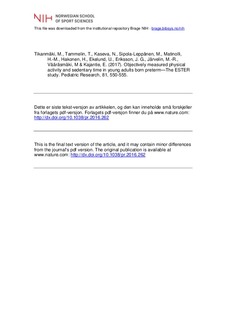| dc.contributor.author | Tikanmäki, Marjaana | |
| dc.contributor.author | Tammelin, Tuija | |
| dc.contributor.author | Kaseva, Nina | |
| dc.contributor.author | Sipola-Leppänen, Marika | |
| dc.contributor.author | Matinolli, Hanna-Maria | |
| dc.contributor.author | Hakonen, Harto | |
| dc.contributor.author | Ekelund, Ulf | |
| dc.contributor.author | Eriksson, Johan G. | |
| dc.contributor.author | Järvelin, Marjo-Riitta | |
| dc.contributor.author | Vääräsmäki, Marja | |
| dc.contributor.author | Kajantie, Eero | |
| dc.date.accessioned | 2017-08-22T11:34:56Z | |
| dc.date.available | 2017-08-22T11:34:56Z | |
| dc.date.issued | 2017 | |
| dc.identifier.citation | Pediatric Research. 2017, 81, 550-555 | nb_NO |
| dc.identifier.uri | http://hdl.handle.net/11250/2451455 | |
| dc.description | I Brage finner du siste tekst-versjon av artikkelen, og den kan inneholde ubetydelige forskjeller fra forlagets pdf-versjon. Forlagets pdf-versjon finner du på www.nature.com / In Brage you'll find the final text version of the article, and it may contain insignificant differences from the journal's pdf version. The definitive version is available at www.nature.com | nb_NO |
| dc.description.abstract | Background: Young adults born preterm have higher levels of cardio metabolic risk factors and they report less physical activity than their peers born at term. Physical activity provides important cardio metabolic health benefits. We hypothesized that objectively measured physical activity levels are lower and time spent sedentary is higher among preterm-born individuals compared with controls. Methods: We studied unimpaired participants of the ESTER birth cohort study at age 23.3 y (SD: 1.2): 60 born early preterm (<34 wk), 108 late preterm (34–36 wk), and 178 at term (controls). Physical activity and sedentary time were measured by hip-worn accelerometer (ActiGraph). Results: As compared with controls’ (mean physical activity, 303 counts per minute (cpm; SD 129)), physical activity was similar among adults born early preterm (mean difference = 21 cpm, 95% CI −61, 19) or late preterm (5 cpm, −27, 38). Time spent sedentary was also similar. Adjustments for early life confounders or current mediating characteristics did not change the results. Conclusion: In contrast to our hypothesis, we found no difference in objectively measured physical activity or time spent sedentary between adults born preterm and at term. The previously reported differences may be limited to physical activity captured by self-report. | nb_NO |
| dc.language.iso | eng | nb_NO |
| dc.publisher | Springer Nature | nb_NO |
| dc.subject | accelerometry | |
| dc.subject | cohort studies | |
| dc.subject | exercise | |
| dc.subject | female | |
| dc.subject | Finland | |
| dc.subject | follow-up studies | |
| dc.subject | health status | |
| dc.subject | humans | |
| dc.subject | male | |
| dc.subject | premature birth | |
| dc.subject | risk factors | |
| dc.subject | sedentary lifestyle | |
| dc.subject | self report | |
| dc.subject | treatment outcome | |
| dc.subject | young adult | |
| dc.title | Objectively measured physical activity and sedentary time in young adults born preterm—The ESTER study | nb_NO |
| dc.type | Journal article | nb_NO |
| dc.type | Peer reviewed | nb_NO |
| dc.source.journal | Pediatric Research | nb_NO |
| dc.identifier.doi | 10.1038/pr.2016.262 | |
| dc.description.localcode | Seksjon for idrettsmedisinske fag / Department of Sports Medicine | nb_NO |
